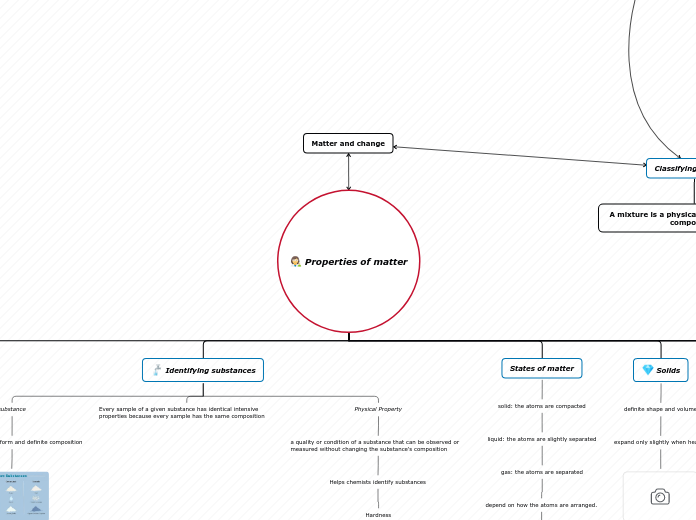Properties of matter
Describing matter
intensive properties
a property that depends on the type of matter in a sample, not the amount of matter
Extensive Properties
a property that depends on the amount of matter in a sample
Identifying substances
substance
matter that has a uniform and definite composition
Every sample of a given substance has identical intensive properties because every sample has the same composition
Physical Property
a quality or condition of a substance that can be observed or measured without changing the substance's composition
Helps chemists identify substances
Hardness
color
conductivity
malleability
Room temperature = 20C - 25C

States of matter
solid: the atoms are compacted
liquid: the atoms are slightly separated
gas: the atoms are separated
depend on how the atoms are arranged.
Solids
definite shape and volume
expand only slightly when heated


Liquids
Indefinite shape, flows
fixed volume (wherever you put the liquid, that is the volume
Expand only slightly when heated


Gases
takes both, the shape and volume of the container
they can easily be compressed
Vapor: Gaseous state, water -> vapor normal state: liquid or solid that turns into vapor
Gas: Oxygen, hydrogen, helium

Physical changes
Melting point, Boiling point
color
state
breaks, cuts, crashes
reversible or irriversible
Gallium -> melts on your hand
Physical changes can be reversible or irreversible

Classifying Mixtures
A mixture is a physical blend of 2 or more components
Based on the distribution of their components, mixtures can be classified as heterogeneous mixtures or as homogeneous mixtures
Heterogeneous mixtures
A mixture in which the composition is not uniform throughout

homogeneous
is a mixture in which the composition is uniform throughout. Another name for homogeneous mixtures is a solution.
The term phase is used to describe any part of a sample with uniform composition and properties
By definition, a homogeneous mixture consists of 2 or more phases.

Matter and change
Separating Mixtures
Differences on physical properties can be used to separate mixtures
Ways to separate mixtures are:
Filtration: the process that separates a solid from the liquid in a heterogeneous mixture
Distillation: a liquid is boiled to produce a vapor that is then condensed into a liquid.

